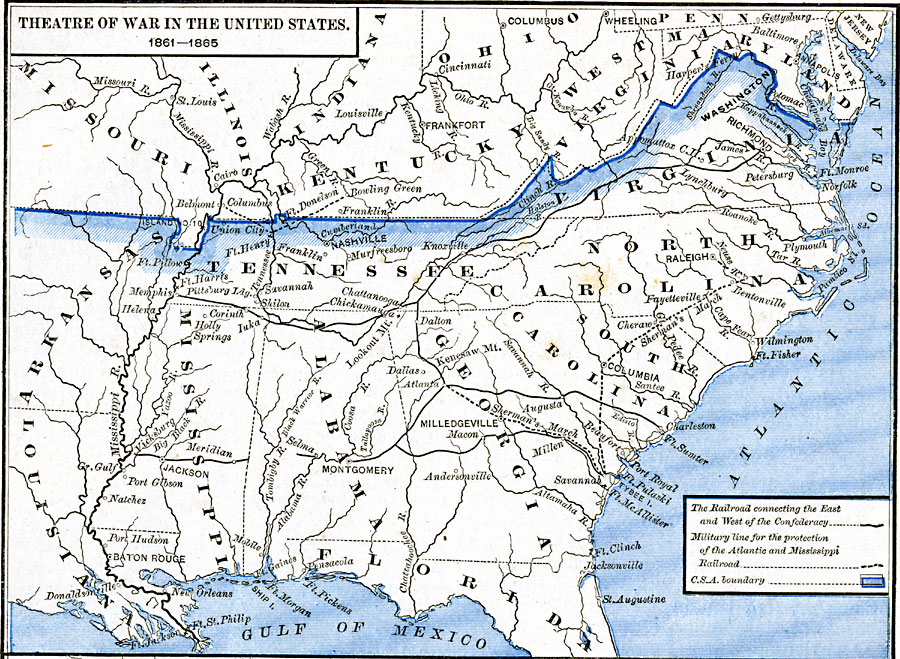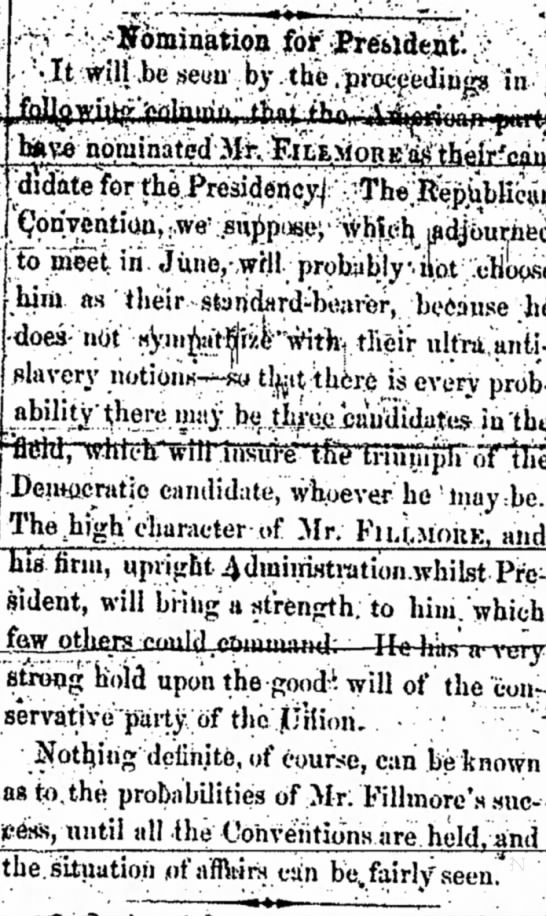
Posted on 03/01/2016 5:06:06 AM PST by Homer_J_Simpson

Especially as the war dragged on, year after year, with the Confederacy's lack of industrial capacity to produce more rail, engines & other equipment, to make up for both war losses and normal wear & tear.
But I suspect the real problem, from the beginning, was a lack of strategic vision of how to use their interior lines to move men & materials from one battle-front to another.
It's one of those great Civil War "what ifs".
henkster: "I’d also like to see a railroad map for 1865."
For the Confederacy, it would be the same as 1860, less damages brought by war.
There were to have been simultaneous attacks by:
That every attack failed is blamed by Lee's admirers on his subordinates, especially ultimately, future Republican Longstreet, and by Lee-skeptics it's blamed on, among other reasons, Lee's woefully inadequate staff.
Substitute "Japan" for "the Confederacy" and "merchant shipping" for "rail, engines and other equipment" and you've described World War 2 in the Pacific.
By the way, great resources submitted by everybody. It's good to have the band back together.
You can say the same thing about northern railroads west of the Appalachians; they are laid out east-west to get agricultural products to market and export. It’s just a lot more developed. Once again, the wealth supposedly created or held in the form of slaves does not translate into economic growth. Slavery is a bad business plan.
Interesting.
Well I do know that from a musical perspective - people think of the “Delta” from where “Delta Blues” derive as some old, hoary region - when in fact that opposite is true - growing cotton in the areas around the Mississippi from Memphis on down was a more recent arrival than most people think.
My point is that while the South looked like it had a lot of territory 1856 or what have you, it was as you say an agrarian nation whereas the North was rapidly industrializing. Railroads as a proxy for urban and industrial development *as well as* railroads as a legitimate instrument of modern war (that is to say useful in their own right for waging war and not just a proxy for industrial strength) tell a story different from the territorial one.
Of course, but it's not that simple.
Remember that term "Jeffersonian democracy" and what it implied at the time:
In terms of our Founding ideals, the South in 1860 was closer to Jefferson's model than a more industrialized North.
The following is from Historic Texas Net. [Paragraph breaks for readability and minor typo corrections are mine.]
Alleyton CSA. Born as War clouds gathered. Alleyton was a key point on the supply line of the Confederate States of American during the Civil War. It was both beginning and end of the cotton road leading to the Confederacy's back door on the Rio Grande River. By 1860 the Buffalo Bayou, Brazos and Colorado Railroad extended from Harrisburg, near Houston, to Alleyton. As a railhead Alleyton became the site of an important cotton station and Quartermaster Depot during the War.
Cotton came here from north and east Texas. From Louisiana, and from Arkansas on the Rails of the B.B.B. & C. and via wagon roads. From Alleyton the South's most precious trading commodity was carried to a point on the Colorado River across from Columbus. It was then ferried across for the start of a long, tortuous journey to the Rio Grande.
The bales of cotton were hauled on big-bedded wagons and high-wheeled Mexican carts, pulled by mules, horses or oxen. The Cotton Road led to Goliad, San Patricio, the King Ranch and finally to Brownsville. Shreds of white fluff on bush and cactus marked the trail of the wagon trains. From Brownsville the cotton was taken across the river to Matamoros, Mexico and subsequently placed on board ships bound for Europe. As the only major gap in the Federal naval blockade of the Confederacy, neutral Matamoros was the place of exchange for outgoing cotton and imported munitions, clothing and medicine.
When Federal forces took Vicksburg in 1863 the Mississippi River was sealed off and the Confederacy divided. The Texas-Mexico trade routes became the South's major military supply lines in the trans-Mississippi west. Alleyton was a main destination of the wagon trains returning from the Rio Grande. Rifles, swords, shirts, pants, alum, arrowroot and other items needed by soldier and civilian in the harried Confederacy were unloaded here for new destinations.
- Historical Marker Text. Marker erected 1963. Located on FM 102, 2/10 mile south of IH-10 about four miles E of Columbus.
I found that highway marker at Alleyton years ago. Until then I had no idea of Alleyton's history or importance during the war.
I note that EternalVigilance's 1861 map in post 16 shows that rail line west of Houston.
Here is a direct link to the Chicopee Weekly Journal, March 1, 1856, that Eternal Vigilance posted yesterday. Thank you EV. If you plan to post this weekly you might address it to the ping list on my profile. (Civil War list, not WWII list).
http://www.chicopeepubliclibrary.org/archives/files/original/a72b80b2f281be0534b85642ff6682c3.pdf
One of the generally less well known aspects of WWII in the Pacific was how effective the U.S. submarine fleet was at eradicating Japanese merchant shipping. It wasn’t headline worthy, but it was very effective, after they got the early war torpedo fuse issue sorted out. I recommend Silent Victory on this subject.
< /digression>
Silent Victory is in my library; I consider it the authoritative book on the subject.
Of course, we always hear that Pickett never forgave Lee. Many years later Pickett was asked why he thought the charge failed. His response was, “I think the Yankees had a lot to do with it.”
After the “Pickett-Pettigrew-Trimble Charge” Lee told Pickett he needed to look after his division. Pickett responded “General Lee, I have no division”.
I will chime in on the railroad expansion in the Missouri/Kansas area. If you notice, prior to the Civil War the crossing of the Mississippi at Hannibal was extended to mid-Missouri and went through Moberly, Missouri. It was called Magic Town due to its growth in that era. It then extended and at Saint Joseph, a town that was to push over 100k in the late 1800s, it was a simple crossing to Kansas at what came to be called the Pony Express crossing as there were firm bluffs on the Missouri side close to the river.
Then, i the Civil War, St. Joseph went strongly to the confederate side. The Kansas City crossing was much more complex, but it won out. The Hannibal Railroad swing bridge was built in the Kansas City area near where the Missouri River is joined by the Kansas River and turns north to head to Nebraska forming the border from that point between Kansas and Missouri.
That bridge was started and 1867 just after the Civil War and would turn out to promote Kansas City enough to cause it to grow and Saint Joseph to later wain because they did not get a rail bridge for a further five years. Kansas City, Missouri and Kansas City, Kansas had four huge river bottom areas that became vast rail yards over the next fifty years.
Kansas City was controlled by the Union during the war and Saint Joseph was not. Central Missouri of Moberly lost its great growth as well as now trans’Missouri rail lines to the south of the river could reach with rail bottoms in Kansas City to cross over and go west and the Hannibal to Moberly line lost its exclusive early start.
Thanks!
I had to get out my old road atlas to locate the towns mentioned, but did, and find it quite interesting.
Very, very interesting. Thank you very much.
I had family in all four states that join in that region, Kansas, Missouri, Nebraska, and Iowa. Almost certainly on both sides of the conflict that was growing.
I have a whole lot of forebears buried in Sidney, Iowa, including one veteran of the War of 1812. That area has an amazing history as the gateway for abolitionist-minded Yankees into bleeding Kansas. Several of my great-great grandparents passed through there on their way to Fort Scott, Kansas, where they died young-in 1857, I think. I’ve never been able to find out whether they died via violence or disease. Could have been either, since both were rampant.
My schedule is so crazy right now, and promises to be through the rest of the year, that I can’t make any promises about reliably posting anything on a regular basis. If you or anyone else wants to adopt and use that source, please do.
Of course I’ll come in here when I can, and add when I can. Obviously, I consider the subject matter to be deeply important and engaging. :-)
Thanks for the correction, was just thinking about that earlier.
Also, in my post #22 listing of four elements of Lee's July 3 plan, I forgot element #5: Porter Alexander's artillery barrage against Union lines, perhaps the greatest such in history to that time.
It was even claimed that Lee's cannons could be heard as far away as Harrisburg.
So, they should have done terrible harm to Union forces.
But, in the end, as with Lee's other assaults on July 3, his artillery barrage failed to do serious damage.
Bottom line: there were five elements to Lee's plan of attack on July 3.
Had the others succeeded, then "Pickett's charge" would have a very different outcome.
Curiously, until it was all over, Union General Mead expected Lee to succeed, and was busy in the rear organizing his army's retreat!
In the 1850s, to filibuster meant to go adventuring, even gallivanting, in foreign countries, especially Caribbean or Central American lands, to overthrow their governments and set up one's own little satrapy.
They all eventually failed, but included in filibustering was the idea of finding new lands for US slavery's expansion.
This particular article doesn't use the word "filibuster", though others similar do, and the Adams Sentinel of Gettysburg, PA will too, soon enough.

Adams Sentinel of Gettysburg, PA
Politics!
Yes, they had politics in 1856 too, and here we see a discussion and prescient prediction about the outcome of the November 1856 election.

Disclaimer: Opinions posted on Free Republic are those of the individual posters and do not necessarily represent the opinion of Free Republic or its management. All materials posted herein are protected by copyright law and the exemption for fair use of copyrighted works.